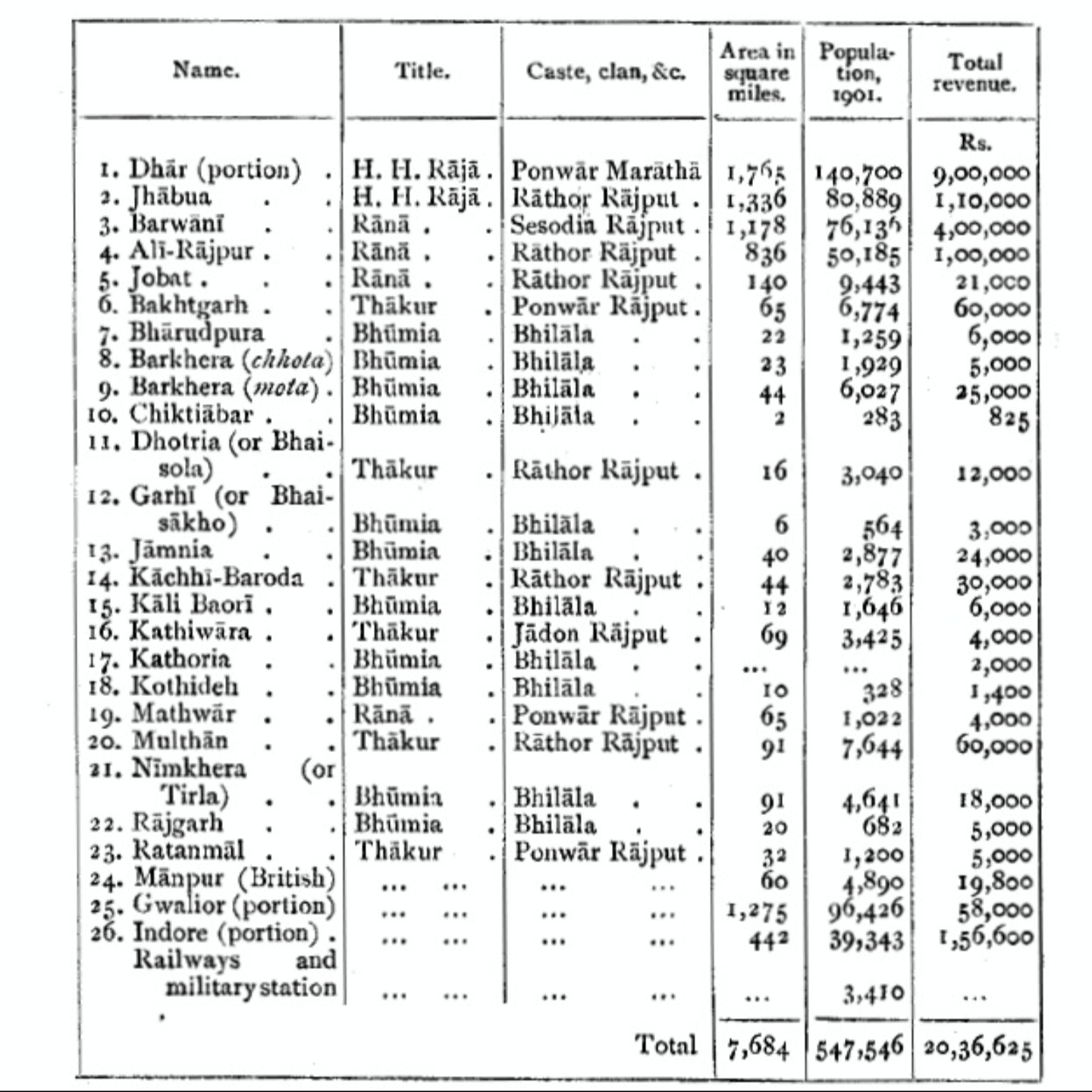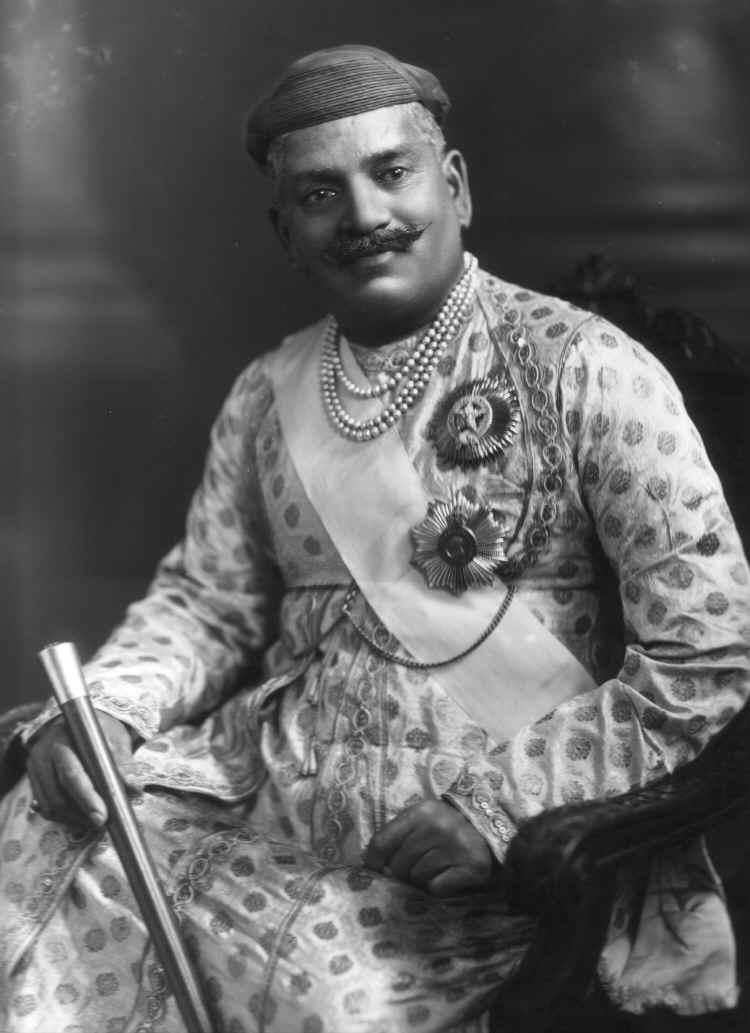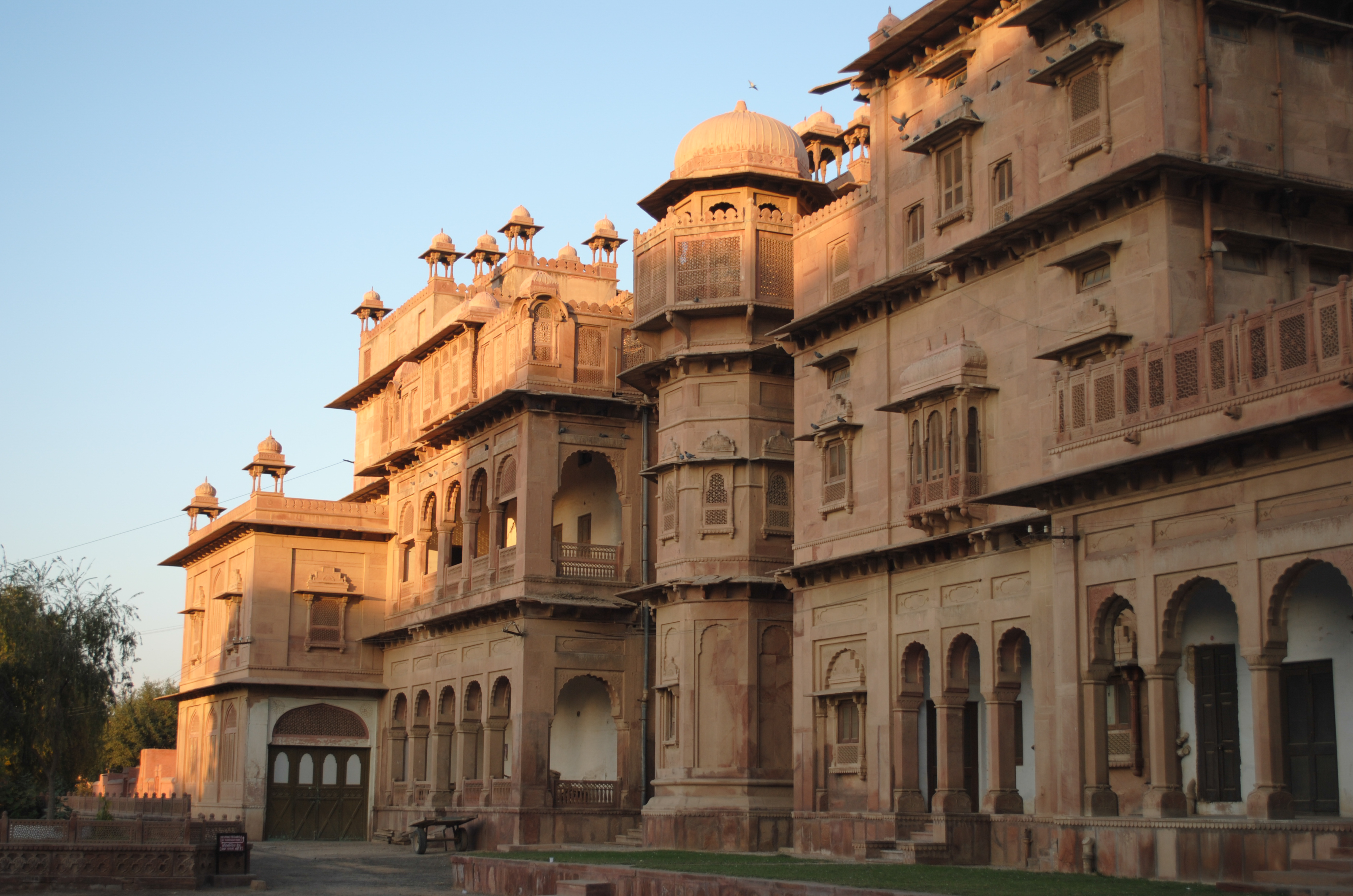|
Bakhatgarh
Bakhatgarh is a town and former princely state in the Dhar district, Madhya Pradesh, India. The royal family of Bakhatgarh (a prominent parmar clan of Malwa, and perhaps the oldest) belongs to Mahipawat sub-clan of Paramara Rajputs. They are descendants of King Bhoja. History The princely state of Bakhatgarh was founded by Rao Nagmalji a Parmar rajput in 1395. The capital of the state was Pitgara until 1765 when Rao Bakhat singhji shifted the capital to the newly found village of Bakhatgarh. The Raos of Bakhatgarh were also the Mandloi of Badnawar pargana. The mandloiship of Badnawar was granted to Rao Daulat Singhji of Bakhatgarh by Mughal emperor. The state consist of 32 Istimirar villages, 3 Inam villages, 9 Khasgi villages (7 Badi Khasgi and 2 Choti Khasgi) and 27 hamlets. The state had an area of 171 square kilometers and yielded a revenue of Rs 80,000 in 1915. During British Raj, the Badnawar pargana consisted of 158 villages of which 101 were guaranteed, 23 were kh ... [...More Info...] [...Related Items...] OR: [Wikipedia] [Google] [Baidu] |
Badnawar
Badnawar (or Badnavar) is a Town, former pargana and a Nagar Parishad of the Dhar district in the state of Madhya Pradesh, India. This is a tehsil place having 170 villages. Badnawar is around 95 km from Indore - the business capital of Madhya Pradesh. in AD 783. It remained a major Jain center until mid 13th century. Schools * K C Saraf Vidhyalaya * Kashyap Vidhya Peeth * Unnati Public School * Nandaram Chopra Higher Secondary School * Unnati Academy * Jagrati Vidhya Mandir * Suraj Vidhya Vihar * Shri Sardar Patel Vidhyapeeth * Pratap Vidhya Niketan * Shri Aaiji Public School * Jain Public School Geography Badnawar is located at . It has an average elevation of 506 metres (1,660 feet). History Acharya Jinasena started the composition of Harivamsa Purana here in AD 783. Jayavarmadeva, A Paramara ruler, had issued a grant mentioning Vardhamanapur, which was found at Ujjain. Some of the ancient Jain images found here are now displayed in the Digambar Jain Mus ... [...More Info...] [...Related Items...] OR: [Wikipedia] [Google] [Baidu] |
Bhopawar Agency States And Estates
Bhopawar Agency was a sub-agency of the Central India Agency in British India with the headquarters at the town of Bhopawar, so the name. Bhopawar Agency was created in 1882 from a number of princely states in the Western Nimar and Southern Malwa regions of Central India belonging to the former Bhil Agency and Bhil Sub-agency with the capitals at Bhopawar and Manpur. The agency was named after Bhopawar, a village in Sardarpur tehsil, Dhar District of present-day Madhya Pradesh state. Manpur remained a strictly British territory. The other chief towns of this region were: Badnawar, Kukshi, Manawar and Sardarpur, Chadawad Estate, Dattigaon. The mighty Vindhya and Satpura ranges crossed the territory of the agency roughly from east to west, with the fertile valley of the Narmada River lying between them. The agency also included the "Bhil Country", inhabited by the Bhil people. History At the time of its 1882 establishment, the agency had a total area of , and its popul ... [...More Info...] [...Related Items...] OR: [Wikipedia] [Google] [Baidu] |
Rao Bahadur Rao Shree Sardar Singh Of Bakhatgarh
__NOTOC__ Rao may refer to: Geography * Rao, West Sumatra, one of the districts of West Sumatra, Indonesia * Råö, a locality in Kungsbacka Municipality, Halland County, Sweden Transport * Dr. Leite Lopes–Ribeirão Preto State Airport , IATA code RAO, serving Ribeirão Preto, Brazil Fictional entities * Rao (comics), a fictional star in the DC Universe; Superman's planet Krypton revolved around it * Rao (''Greyhawk''), god of peace, reason, and serenity in ''Dungeons & Dragons: World of Greyhawk'' * ''Raō'', the Japanese name for Raoh, a character in ''Fist of the North Star'' Mathematics * Cramér–Rao bound, a statistical concept * Rao–Blackwell theorem, a theorem in statistics Science * ''Rao'' (insect), a genus of wasps in the subfamily Platygastrinae * Recent African origin of modern humans (RAO), a paleoanthropological theory * Recurrent airway obstruction (RAO), a respiratory disease in horses * Response amplitude operator (RAO), a function relating a ... [...More Info...] [...Related Items...] OR: [Wikipedia] [Google] [Baidu] |
Thakur (title)
Thakur is a historical feudal title of the Indian subcontinent. It is also used as a surname in the present day. The female variant of the title is Thakurani or Thakurain, and is also used to describe the wife of a Thakur. There are varying opinions among scholars about its origin. Some scholars suggest that it is not mentioned in the Sanskrit texts preceding 500 BCE, but speculates that it might have been a part of the vocabulary of the dialects spoken in northern India before the Gupta Empire. It is viewed to have been derived from word ''Thakkura'' which, according to several scholars, was not an original word of the Sanskrit language but a borrowed word in the Indian lexis from the Tukhara regions of Inner Asia. Another view-point is that ''Thakkura'' is a loan word from the Prakrit language. Scholars have suggested differing meanings for the word, i.e. "god", "lord", and "master of the estate". Academics have suggested that it was only a title, and in itself, did not ... [...More Info...] [...Related Items...] OR: [Wikipedia] [Google] [Baidu] |
British Raj
The British Raj (; from Hindi language, Hindi ''rāj'': kingdom, realm, state, or empire) was the rule of the British The Crown, Crown on the Indian subcontinent; * * it is also called Crown rule in India, * * * * or Direct rule in India, * Quote: "Mill, who was himself employed by the British East India company from the age of seventeen until the British government assumed direct rule over India in 1858." * * and lasted from 1858 to 1947. * * The region under British control was commonly called India in contemporaneous usage and included areas directly administered by the United Kingdom of Great Britain and Ireland, United Kingdom, which were collectively called Presidencies and provinces of British India, British India, and areas ruled by indigenous rulers, but under British British paramountcy, paramountcy, called the princely states. The region was sometimes called the Indian Empire, though not officially. As ''India'', it was a founding member of the League of Nations, a ... [...More Info...] [...Related Items...] OR: [Wikipedia] [Google] [Baidu] |
Mughal Emperor
The Mughal emperors ( fa, , Pādishāhān) were the supreme heads of state of the Mughal Empire on the Indian subcontinent, mainly corresponding to the modern countries of India, Pakistan, Afghanistan and Bangladesh. The Mughal rulers styled themselves as " padishah", a title usually translated from Persian as " emperor". They began to rule parts of India from 1526, and by 1707 ruled most of the sub-continent. After that they declined rapidly, but nominally ruled territories until the Indian Rebellion of 1857. The Mughals were a branch of the Timurid dynasty of Turco-Mongol origin from Central Asia. Their founder Babur, a Timurid prince from the Fergana Valley (modern-day Uzbekistan), was a direct descendant of Timur (generally known in western nations as Tamerlane) and also affiliated with Genghis Khan through Timur's marriage to a Genghisid princess. Many of the later Mughal emperors had significant Indian Rajput and Persian ancestry through marriage alliances as e ... [...More Info...] [...Related Items...] OR: [Wikipedia] [Google] [Baidu] |
Pargana
Pargana ( bn, পরগনা, , hi, परगना, ur, پرگنہ) or parganah, also spelt pergunnah during the time of the Sultanate period, Mughal times and British Raj, is a former administrative unit of the Indian subcontinent and each ''Parganas'' may or may not subdivided into some ''pirs''. Those revinue units are used primarily, but not exclusively, by the Muslim kingdoms. After independence the Parganas became equivalent to Block/ Tahsil and Pirs became Grampanchayat. ''Parganas'' were introduced by the Delhi Sultanate. As a revenue unit, a pargana consists of several ''mouzas'', which are the smallest revenue units, consisting of one or more villages and the surrounding countryside. Under the reign of Sher Shah Suri, administration of parganas was strengthened by the addition of other officers, including a ''shiqdar'' (police chief), an ''amin'' or ''munsif'' (an arbitrator who assessed and collected revenue) and a ''karkun'' (record keeper). Mughal era In th ... [...More Info...] [...Related Items...] OR: [Wikipedia] [Google] [Baidu] |
Rao (title)
''Rai'' ( ur, , ; bn, রায়) is a historical title of royalty and nobility in the Indian subcontinent used by rulers and chieftains of many princely states. It is derived from ''Raja'' (king, prince or chief). The Marathi/Telugu variant Rai was used as a substitute to King. Rai has no trace in sanskrit origin. When Babur conquered Hindustan, he found many principalities which had been subordinated by the Emperor of Hindustan and innumerable others which never have been effectively subdued. When Akbar ascended to the throne, Hindustan had numerous autonomous and semiautonomous rulers. These hereditary rulers were known by various names such as ''Rais'', ''Rajas'', ''Ranas'', and ''Rawals''. During Mughal rule, while conferring a title on a Hindu or Sikh Chief the word Raja or Rai was added to the name of person. The Mughals seems to have inherited the practice of bestowing titles from the Sultans of Delhi. The appellation "Rai" is primarily applied to men, while for wom ... [...More Info...] [...Related Items...] OR: [Wikipedia] [Google] [Baidu] |
Bhoja
Bhoja (reigned c. 1010–1055 CE) was an Indian king from the Paramara dynasty. His kingdom was centered around the Malwa region in central India, where his capital Dhara-nagara (modern Dhar) was located. Bhoja fought wars with nearly all his neighbours in attempts to extend his kingdom, with varying degrees of success. At its zenith, his empire extended from Chittor in the north to upper Konkan in the south, and from the Sabarmati River in the west to Vidisha in the east. Because of his patronage to scholars, Bhoja became one of the most celebrated kings in the Indian history. After his death, he came to be featured in several legends as a righteous scholar-king. The body of legends clustered around him is comparable to that of the Emperor Vikramaditya. Bhoja is best known as a patron of arts, literature, and sciences. The establishment of the Bhoj Shala, a centre for Sanskrit studies, is attributed to him. He was a polymath, and several books covering a wide range of ... [...More Info...] [...Related Items...] OR: [Wikipedia] [Google] [Baidu] |
Princely State
A princely state (also called native state or Indian state) was a nominally sovereign entity of the British Indian Empire that was not directly governed by the British, but rather by an Indian ruler under a form of indirect rule, subject to a subsidiary alliance and the suzerainty or paramountcy of the British crown. There were officially 565 princely states when India and Pakistan became independent in 1947, but the great majority had contracted with the viceroy to provide public services and tax collection. Only 21 had actual state governments, and only four were large ( Hyderabad State, Mysore State, Jammu and Kashmir State, and Baroda State). They acceded to one of the two new independent nations between 1947 and 1949. All the princes were eventually pensioned off. At the time of the British withdrawal, 565 princely states were officially recognised in the Indian subcontinent, apart from thousands of zamindari estates and jagirs. In 1947, princely states covered ... [...More Info...] [...Related Items...] OR: [Wikipedia] [Google] [Baidu] |
Rajputs
Rajput (from Sanskrit ''raja-putra'' 'son of a king') is a large multi-component cluster of castes, kin bodies, and local groups, sharing social status and ideology of genealogical descent originating from the Indian subcontinent. The term Rajput covers various patrilineal clans historically associated with warriorhood: several clans claim Rajput status, although not all claims are universally accepted. According to modern scholars, almost all Rajput clans originated from peasant or pastoral communities. Over time, the Rajputs emerged as a social class comprising people from a variety of ethnic and geographical backgrounds. During the 16th and 17th centuries, the membership of this class became largely hereditary, although new claims to Rajput status continued to be made in the later centuries. Several Rajput-ruled kingdoms played a significant role in many regions of central and northern India from seventh century onwards. The Rajput population and the former Rajput states ... [...More Info...] [...Related Items...] OR: [Wikipedia] [Google] [Baidu] |
Paramara
The Paramara dynasty ( IAST: Paramāra) was an Indian dynasty that ruled Malwa and surrounding areas in west-central India between 9th and 14th centuries. They belonged to the Parmara clan of the Rajputs. The dynasty was established in either the 9th or 10th century, and its early rulers most probably ruled as vassals of the Rashtrakutas of Manyakheta. The earliest extant Paramara inscriptions, issued by the 10th-century ruler Siyaka, have been found in Gujarat. Around 972 CE, Siyaka sacked the Rashtrakuta capital Manyakheta, and established the Paramaras as a sovereign power. By the time of his successor Munja, the Malwa region in present-day Madhya Pradesh had become the core Paramara territory, with Dhara (now Dhar) as their capital. The dynasty reached its zenith under Munja's nephew Bhoja, whose kingdom extended from Chittor in the north to Konkan in the south, and from the Sabarmati River in the west to Vidisha in the east. The Paramara power rose and declined s ... [...More Info...] [...Related Items...] OR: [Wikipedia] [Google] [Baidu] |







